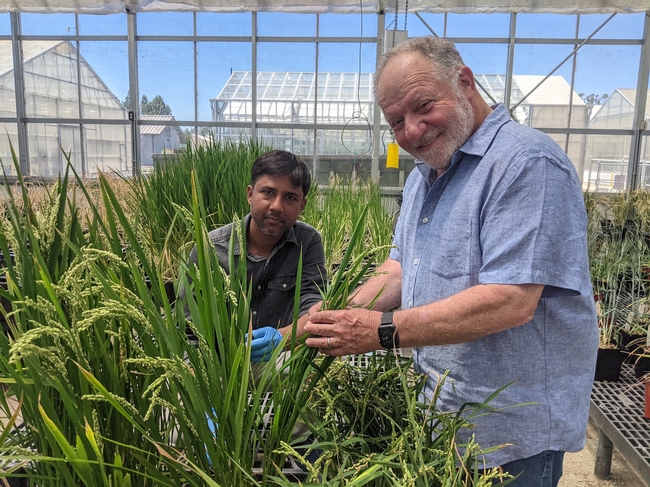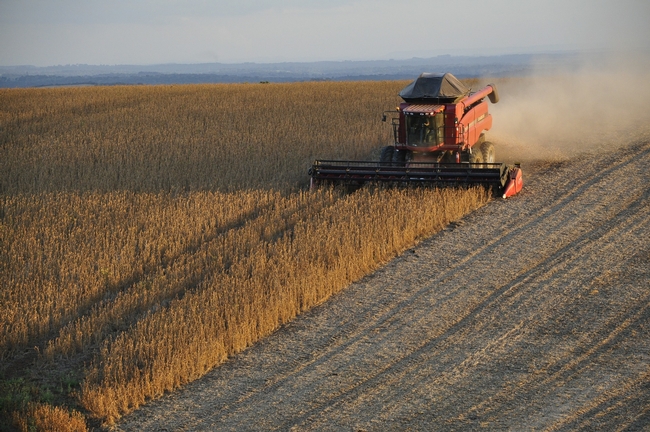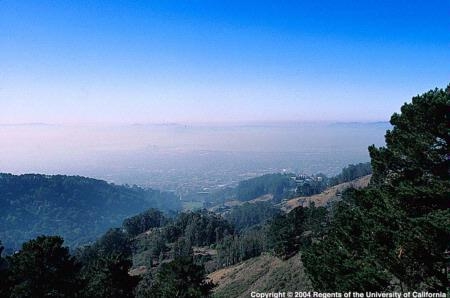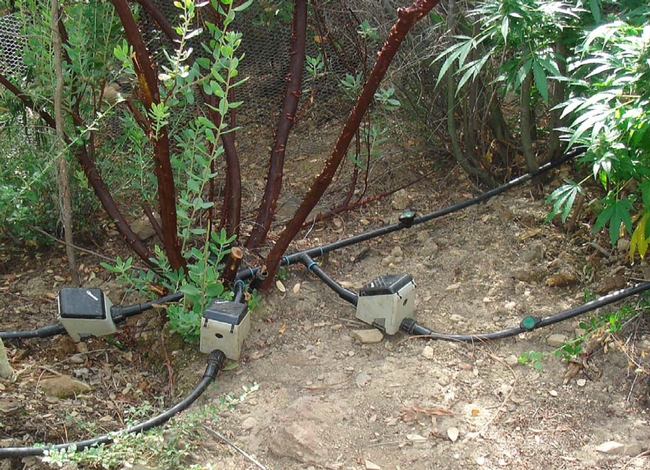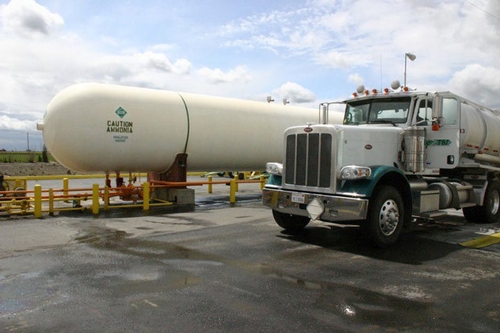Posts Tagged: pollution
Growing cereal crops with less fertilizer
Discovery could reduce nitrogen pollution, save farmers billions
Researchers at the University of California, Davis, have found a way to reduce the amount of nitrogen fertilizers needed to grow cereal crops. The discovery could save farmers in the United States billions of dollars annually in fertilizer costs while also benefiting the environment.
The research comes out of the lab of Eduardo Blumwald, a distinguished professor of plant sciences, who has found a new pathway for cereals to capture the nitrogen they need to grow.
The discovery could also help the environment by reducing nitrogen pollution, which can lead to contaminated water resources, increased greenhouse gas emissions and human health issues. The study was published in the journal Plant Biotechnology.
Nitrogen is key to plant growth, and agricultural operations depend on chemical fertilizers to increase productivity. But much of what is applied is lost, leaching into soils and groundwater. Blumwald's research could create a sustainable alternative.
“Nitrogen fertilizers are very, very expensive,” Blumwald said. “Anything you can do to eliminate that cost is important. The problem is money on one side, but there are also the harmful effects of nitrogen on the environment.”
A new pathway to natural fertilizer
Blumwald's research centers on increasing the conversion of nitrogen gas in the air into ammonium by soil bacteria — a process known as nitrogen fixation.
Legumes such as peanuts and soybeans have root nodules that can use nitrogen-fixing bacteria to provide ammonium to the plants. Cereal plants like rice and wheat don't have that capability and must rely on taking in inorganic nitrogen, such as ammonia and nitrate, from fertilizers in the soil.
“If a plant can produce chemicals that make soil bacteria fix atmospheric nitrogen gas, we could modify the plants to produce more of these chemicals,” Blumwald said. “These chemicals will induce soil bacterial nitrogen fixation and the plants will use the ammonium formed, reducing the amount of fertilizer used.”
Blumwald's team used chemical screening and genomics to identify compounds in rice plants that enhanced the nitrogen-fixing activity of the bacteria.
Then they identified the pathways generating the chemicals and used gene editing technology to increase the production of compounds that stimulated the formation of biofilms. Those biofilms contain bacteria that enhanced nitrogen conversion. As a result, nitrogen-fixing activity of the bacteria increased, as did the amount of ammonium in the soil for the plants.
“Plants are incredible chemical factories,” he said. “What this could do is provide a sustainable alternative agricultural practice that reduces the use of excessive nitrogen fertilizers.”
The pathway could also be used by other plants. A patent application on the technique has been filed by the University of California and is pending.
Dawei Yan, Hiromi Tajima, Howard-Yana Shapiro, Reedmond Fong and Javier Ottaviani from UC Davis contributed to the research paper, as did Lauren Cline from Bayer Crop Science. Ottaviani is also a research associate at Mars Edge.
The research was funded by the Will W. Lester Endowment. Bayer Crop Science is supporting further research on the topic.
Editor's note: Blumwald is affiliated with UC Agriculture and Natural Resources through the Agricultural Experiment Station at UC Davis.
Decreases in air pollution boost corn and soybean yield
Faced with growing global food demand, one solution to increasing productivity is cutting air pollution, reported Ohio's Country Journal.
MIT Sloan School of Management visiting professor Konstantinos Metaxoglou and UC Davis ag economics professor Aaron Smith quantified crop yield increases attributed to recent reduction in the emissions of NOx from power plants in the U.S. They found that the average corn yield increased by 2.5% and soybeen yield by 1.6% from 2003 to 2011.
The increased yield led to an increase in the two crops' total annual surplus.
“While farmers are worse off and consumers are better off, the economy on the whole benefits because the gain for consumers outweighs the loss for producers,” Metaxoglou said. “Our findings show that reducing NOx and other harmful emissions from power plants is beneficial not only for human health, but also for agriculture production.”
International symposium will explore air pollution’s effect on plants
Air pollution is harmful to the health of people and animals. That much we know, but how does air pollution affect plants?
Scientists from 25 countries will gather on the Monterey Peninsula to discuss “Plants and the Changing Environment” in June. The 9th Air Pollution and Global Change Symposium will be held June 8-12 at the Asilomar Conference Center in Pacific Grove.
The goal of the series is to consider interactions of air pollution and global change and their impacts on vegetation.
“The symposium is unique in dealing with effects at all levels from molecular and cellular mechanisms, whole plant and crop impacts, all the way up to models of ecosystem and regional impacts,” said David A. Grantz, UC Cooperative Extension specialist based in the Department of Botany & Plant Sciences at UC Riverside.
The symposia are held every few years in different countries, the last in Groningen, The Netherlands, in 2011. The event in California is being organized by Grantz and Kent O. Burkey, USDA/ARS plant physiologist and North Carolina State University professor of crop science and botany in Raleigh.
UC scientists and students engaged in research on the interactions of plant function, metabolism and communities with environmental pollution and global change are encouraged to attend.
“This is an important opportunity for U.S. scientists because the last time this symposium was held in the U.S. was in 1992,” said Grantz. “This is a great chance to catch up on the physiological ecology and modeling efforts underway in Europe and Asia.”
The confirmed keynote speakers include
- Dennis Baldocchi, University of California, Berkeley, USA
- Lisa Emberson, Stockholm Environment Institute and University of York, U.K.
- Lisa Ainsworth, USDA/ARS and University of Illinois, USA
- Koike Takayoshi, Hokkaido University, Japan
- Harry Harmens, Centre for Ecology and Hydrology, Environment Centre Wales, U.K.
- Allen Lefohn, ASL and Associates, USA
- Atul Jain, University of Illinois, USA
- Rainer Matyssek, Technische Universitat Munchen, Germany
The deadline for abstracts, registration and lodging is March 31. The agenda, registration and housing information can be found at WWW.APGC.EU.
Pollute, poach, dewater: Legacies of illicit cannabis grows
While the legality of California’s medical marijuana dispensaries is being debated in courtrooms, a UC Cooperative Extension forestry and wildlands ecology advisor says there are a number of issues related to the unregulated land-use practices of illicit cannabis growing that have not been addressed.
“As a forest ecologist, I spend a lot of time outdoors, and I talk to thousands of people every year about forest-related subject matter,” says Greg Giusti. “And you can’t talk to anybody today on the North Coast without the topic of cannabis growing and cannabis impacts on land coming up.”
In Lake and Mendocino counties, Giusti performs research and shares information with public agencies and private landowners in relation to forest management and freshwater ecology on behalf of UC Cooperative Extension. Marijuana farming is not a topic that Giusti ever intended to address.
Effects on natural resources
Most of the data available about illicit cannabis grows is based on drug enforcement actions, specifically how many sites were busted and how many plants or pounds of plant material were seized. Giusti has gathered photographs and anecdotal evidence of the effects on natural resources of commercial-scale marijuana grows operated illicitly on public and private lands.
Some of the effects he has documented:
- illegal water controls (including dams, stream diversion and water storage)
- water pollution from petroleum, pesticide and fertilizer products
- pesticides applied without permits
- pesticides, fertilizers and other chemicals left behind
- indiscriminate fish and wildlife killing (including poisoning, trapping and poaching for food)
- human trash and waste left after camping
“It’s not this green industry that people talk about,” Giusti says. “They’re diverting water, they’re polluting streams, and there’s a portion who are poaching. We’re also seeing all of the negative effects of unregulated road building, unregulated construction and unregulated human inhabitation for months and months out in the woods.”
Giusti explained that some cannabis growers divert water from streams to store in large water bladders, prematurely lowering stream levels during critical times in the year.
“It's illegal to do, but at the same time you can drive up and down Highway 101 and easily buy these huge bladders,” he said.
He notes that local businesses are selling compost by the ton, rodenticide by the pallet, thousands of pairs of clippers and turkey bags in lots of 100.
“Mainstream businesses are supporting this underground industry,” Giusti said. “You don’t have to be growing cannabis to be making money off of it.”
Raising awareness
In 2010, Giusti organized two community workshops in Lake County to address the impacts of illicit cannabis land-use on forest resources, for a combined attendance of nearly 400 community members. Giusti has shared his results with the board of supervisors for Lake and Mendocino counties, local news media, local foresters and the staff of the North Coast Regional Water Quality Control Board.
“My intention was to initiate a communitywide discussion to ask, ‘Is this what you want to happen to your forests?’” Giusti said. “Up until now it's been talked about in hushed tones, and I wanted to initiate a dialogue out loud. Everybody has been whispering about it.”
The presentation he developed for those meetings continues to generate discussion. Most recently, he has presented to the North Coast Water Quality Control Board staff and other agencies. He has shared photos collected for his presentation with Congressman Mike Thompson’s office as well.
“With the water quality control board, I had the opportunity to engage people whose job it is to protect the beneficial uses of water — and hopefully stimulate an internal dialogue so that they can continue the discussion after I leave their office,” he said. “There are other resource agencies that need to be involved, and county planning departments too. This is an unregulated land-use practice.”
This month, the Lake County Record-Bee ran an article by reporter Linda Williams with the headline “Thirsty marijuana grows suck Eel River dry,” which included some information presented at Giusti’s meetings.
“My efforts seem to be improving people's awareness,” he says. “The very thing I wanted to accomplish — creating broader dialogues — is happening.”
View Giusti's presentation: Illicit Cannabis Production on Forest and Wildland Resources
What makes food grow - and why that matters
There’s a lot of attention paid to where food comes from nowadays. Less attention has been paid to what helps that food grow, but that’s an important part of the equation. Whether organic or conventionally grown, the tomatoes, lettuce, plums and other food we eat rely on nutrients in order to grow. One of the most important nutrients for plant productivity is nitrogen.
Nitrogen, which is ubiquitous in our atmosphere in a relatively inert, gaseous form, is not available to most plants unless it is transformed into a reactive form and added to soil, where plants can use it to grow. Most often nitrogen is applied to fields in the form of synthetic fertilizer, although organic production relies on other nitrogen sources, such as cover crops, manure, fish meal and poultry waste.
Agricultural production depends on nitrogen in order to grow reliable, high yielding crops. But this nitrogen, when it is applied to fields in the reactive form that plants can use, also tends to leak out into air and water and cause pollution when all the nitrogen applied to the field is not used up by the plants.
The California Nitrogen Assessment, a project of the Agricultural Sustainability Institute at UC Davis, is taking a hard look at the whole system of nitrogen use in California. While nitrogen is hugely important to producing the food and fiber that we all need, there may be ways to use it more efficiently and reduce the pollution problems it can cause. These problems include air and water pollution, which can have negative consequences for human and environmental health in California.
Since nitrogen is so important to producing the food that all of us eat, the Agricultural Sustainability Institute’s team has involved stakeholders from all around the agricultural system. The assessment team has sought insight from farmers and economists, policy makers and public health groups, and Californians whose drinking water has been polluted by nitrogen, forcing them to buy bottled water on a regular basis. There are many diverse perspectives and ideas about how nitrogen should be managed in California’s future. The assessment will provide a synthesis of the most up-to-date scientific knowledge on science, policy and practice to inform decision making on how to improve nitrogen management.
Thinking about where food comes from is one important part of understanding the food system. Learning about the trade-offs involved in other key agricultural inputs is another.
Find out more about nitrogen and the California Nitrogen Assessment at its website. If you are interested in becoming involved in the assessment as a stakeholder participant, visit the website for more information to learn how you can get involved.

